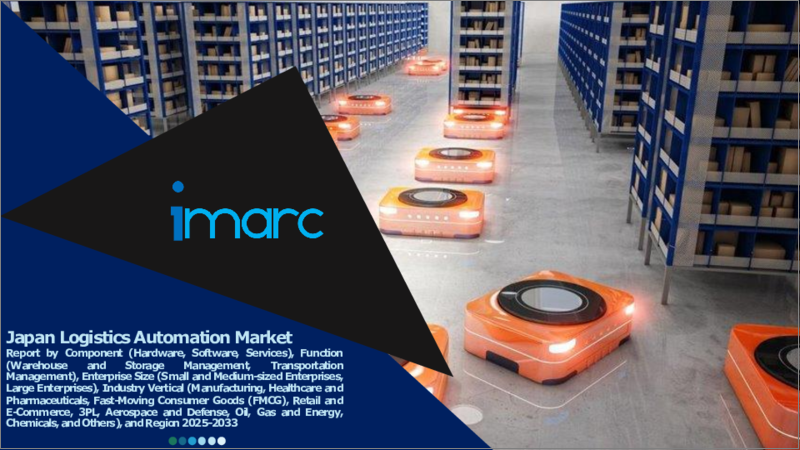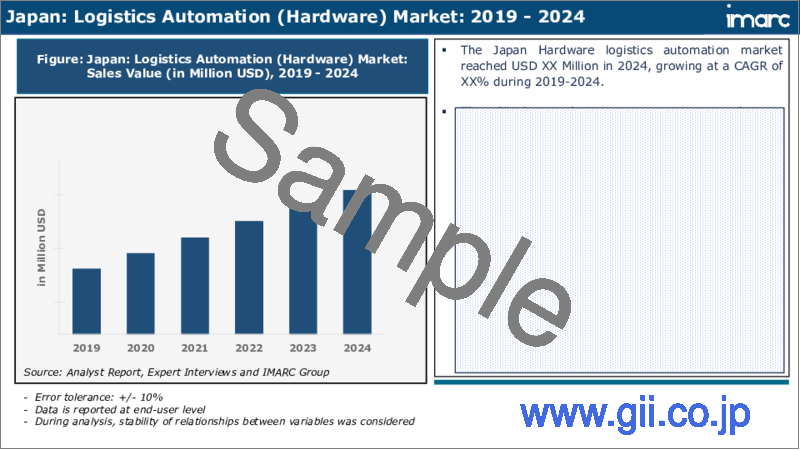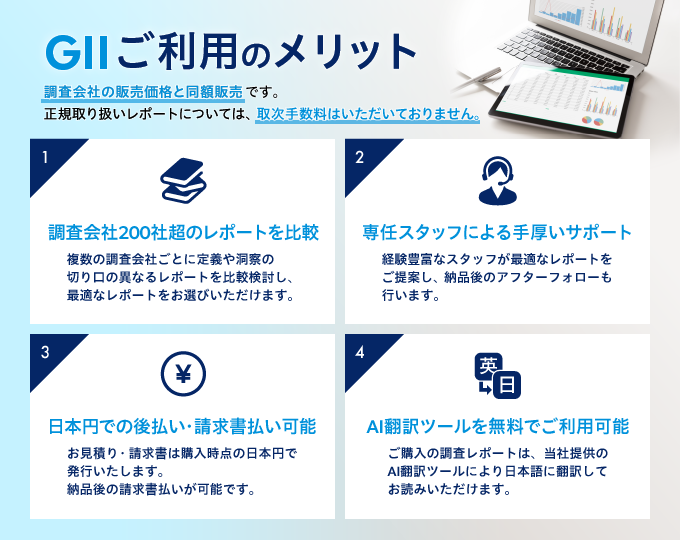|
|
市場調査レポート
商品コード
1609685
日本の物流自動化市場レポート:コンポーネント、機能、企業規模、業界、地域別、2025年~2033年Japan Logistics Automation Market Report by Component, Function, Enterprise Size, Industry Vertical, and Region 2025-2033 |
||||||
カスタマイズ可能
|
|||||||
| 日本の物流自動化市場レポート:コンポーネント、機能、企業規模、業界、地域別、2025年~2033年 |
|
出版日: 2024年12月05日
発行: IMARC
ページ情報: 英文 115 Pages
納期: 5~7営業日
|
全表示
- 概要
- 目次
日本の物流自動化市場の市場規模は2024年に50億米ドルに達しました。今後、IMARC Groupは、市場は2033年までに176億米ドルに達し、2025年から2033年にかけて15.1%の成長率(CAGR)を示すと予測しています。拡大するeコマース分野と、製造技術における数々の進歩が、主に市場成長の原動力となっています。
本レポートで扱う主な質問
- 日本の物流自動化市場はこれまでどのように推移し、今後どのように推移するのか?
- COVID-19が日本の物流自動化市場に与えた影響は?
- 日本の物流自動化市場のコンポーネント別の内訳は?
- 日本の物流自動化市場の機能別の内訳は?
- 日本の物流自動化市場の企業規模別内訳は?
- 日本の物流自動化市場の業界別の内訳は?
- 日本の物流自動化市場のバリューチェーンにはどのような段階がありますか?
- 日本の物流自動化の主な促進要因と課題は?
- 日本の物流自動化市場の構造と主要プレーヤーは?
- 日本の物流自動化市場における競合の程度は?
目次
第1章 序文
第2章 調査範囲と調査手法
- 調査の目的
- ステークホルダー
- データソース
- 市場推定
- 調査手法
第3章 エグゼクティブサマリー
第4章 日本の物流自動化市場:イントロダクション
- 概要
- 市場力学
- 業界動向
- 競合情報
第5章 日本の物流自動化市場情勢
- 過去および現在の市場動向(2019年~2024年)
- 市場予測(2025-2033)
第6章 日本の物流自動化市場:コンポーネント別の内訳
- ハードウェア
- ソフトウェア
- サービス
第7章 日本の物流自動化市場:機能別の内訳
- 倉庫および保管管理
- 輸送管理
第8章 日本の物流自動化市場:企業規模別の内訳
- 中小企業
- 大企業
第9章 日本の物流自動化市場:業界別の内訳
- 製造
- ヘルスケアと医薬品
- 日用消費財(FMCG)
- 小売業とeコマース
- 3PL
- 航空宇宙および防衛
- 石油、ガス、エネルギー
- 化学薬品
- その他
第10章 日本の物流自動化市場:競合情勢
- 概要
- 市場構造
- 市場プレーヤーのポジショニング
- 主要成功戦略
- 競合ダッシュボード
- 企業評価象限
第11章 主要企業のプロファイル
第12章 日本の物流自動化市場:業界分析
- 促進要因・抑制要因・機会
- ポーターのファイブフォース分析
- バリューチェーン分析
第13章 付録
Japan logistics automation market size reached USD 5 Billion in 2024. Looking forward, IMARC Group expects the market to reach USD 17.6 Billion by 2033, exhibiting a growth rate (CAGR) of 15.1% during 2025-2033. The expanding e-commerce sector, along with the numerous advancements in the manufacturing technologies, is primarily driving the market growth.
Logistics automation entails the utilization of control systems, machinery, and software to enhance the efficiency of logistics operations, particularly those conducted within warehouses or distribution centers with limited human involvement. Its advantages encompass the enhancement of customer service quality, scalability, operational speed, organizational oversight, and error reduction. Logistics automation plays a pivotal role in minimizing manual data inaccuracies, ensuring adequate insurance coverage, and facilitating automated notifications. As a result, it is progressively supplanting conventional logistics procedures across both small and large businesses, streamlining and mechanizing a range of tasks including freight handling, tracking, and documentation. Consequently, logistics automation finds widespread application in industries such as retail, automotive, and the food and beverage (F&B) sector.
Japan Logistics Automation Market Trends:
The Japan logistics automation market is primarily influenced by the widespread adoption of high-speed internet and smartphones, driven by the rapid pace of digitization on a global scale. Furthermore, the substantial expansion of the e-commerce sector is generating increased demand for logistics automation solutions. These systems exhibit the capability to automate a wide range of tasks, including container loading and unloading, palletizing, de-palletizing, commissioning, and the efficient feeding of production lines. Additionally, the emergence of the industrial internet of things (IIoT) and the introduction of network-connected systems that enhance task performance across diverse industries are further facilitating market growth. As the number of warehouses continues to rise, organizations are increasingly investing in warehouse automation solutions. This trend, coupled with ongoing advancements in manufacturing and industrial robotics, has led to the development of innovative robotic technologies such as automated guided vehicles, which are expected to create a positive market outlook.
Japan Logistics Automation Market Segmentation:
Component Insights:
- Hardware
- Mobile Robots (AGV, AMR)
- Automated Storage and Retrieval Systems (AS/RS)
- Automated Sorting Systems
- De-palletizing/Palletizing Systems
- Conveyor Systems
- Automatic Identification and Data Collection (AIDC)
- Order Picking
- Software
- Warehouse Management Systems (WMS)
- Warehouse Execution Systems (WES)
- Services
- Value Added Services
- Maintenance
Function Insights:
- Warehouse and Storage Management
- Transportation Management
Enterprise Size Insights:
- Small and Medium-sized Enterprises
- Large Enterprises
Industry Vertical Insights:
- Manufacturing
- Healthcare and Pharmaceuticals
- Fast-Moving Consumer Goods (FMCG)
- Retail and E-Commerce
- 3PL
- Aerospace and Defense
- Oil, Gas and Energy
- Chemicals
- Others
Competitive Landscape:
The market research report has also provided a comprehensive analysis of the competitive landscape in the market. Competitive analysis such as market structure, key player positioning, top winning strategies, competitive dashboard, and company evaluation quadrant has been covered in the report. Also, detailed profiles of all major companies have been provided.
Key Questions Answered in This Report:
- How has the Japan logistics automation market performed so far and how will it perform in the coming years?
- What has been the impact of COVID-19 on the Japan logistics automation market?
- What is the breakup of the Japan logistics automation market on the basis of component?
- What is the breakup of the Japan logistics automation market on the basis of function?
- What is the breakup of the Japan logistics automation market on the basis of enterprise size?
- What is the breakup of the Japan logistics automation market on the basis of industry vertical?
- What are the various stages in the value chain of the Japan logistics automation market?
- What are the key driving factors and challenges in the Japan logistics automation?
- What is the structure of the Japan logistics automation market and who are the key players?
- What is the degree of competition in the Japan logistics automation market?
Table of Contents
1 Preface
2 Scope and Methodology
- 2.1 Objectives of the Study
- 2.2 Stakeholders
- 2.3 Data Sources
- 2.3.1 Primary Sources
- 2.3.2 Secondary Sources
- 2.4 Market Estimation
- 2.4.1 Bottom-Up Approach
- 2.4.2 Top-Down Approach
- 2.5 Forecasting Methodology
3 Executive Summary
4 Japan Logistics Automation Market - Introduction
- 4.1 Overview
- 4.2 Market Dynamics
- 4.3 Industry Trends
- 4.4 Competitive Intelligence
5 Japan Logistics Automation Market Landscape
- 5.1 Historical and Current Market Trends (2019-2024)
- 5.2 Market Forecast (2025-2033)
6 Japan Logistics Automation Market - Breakup by Component
- 6.1 Hardware
- 6.1.1 Overview
- 6.1.2 Historical and Current Market Trends (2019-2024)
- 6.1.3 Market Segmentation
- 6.1.3.1 Mobile Robots (AGV, AMR)
- 6.1.3.2 Automated Storage and Retrieval Systems (AS/RS)
- 6.1.3.3 Automated Sorting Systems
- 6.1.3.4 De-palletizing/Palletizing Systems
- 6.1.3.5 Conveyor Systems
- 6.1.3.6 Automatic Identification and Data Collection (AIDC)
- 6.1.3.7 Order Picking
- 6.1.4 Market Forecast (2025-2033)
- 6.2 Software
- 6.2.1 Overview
- 6.2.2 Historical and Current Market Trends (2019-2024)
- 6.2.3 Market Segmentation
- 6.2.3.1 Warehouse Management Systems (WMS)
- 6.2.3.2 Warehouse Execution Systems (WES)
- 6.2.4 Market Forecast (2025-2033)
- 6.3 Services
- 6.3.1 Overview
- 6.3.2 Historical and Current Market Trends (2019-2024)
- 6.3.3 Market Segmentation
- 6.3.3.1 Value Added Services
- 6.3.3.2 Maintenance
- 6.3.4 Market Forecast (2025-2033)
7 Japan Logistics Automation Market - Breakup by Function
- 7.1 Warehouse and Storage Management
- 7.1.1 Overview
- 7.1.2 Historical and Current Market Trends (2019-2024)
- 7.1.3 Market Forecast (2025-2033)
- 7.2 Transportation Management
- 7.2.1 Overview
- 7.2.2 Historical and Current Market Trends (2019-2024)
- 7.2.3 Market Forecast (2025-2033)
8 Japan Logistics Automation Market - Breakup by Enterprise Size
- 8.1 Small and Medium-sized Enterprises
- 8.1.1 Overview
- 8.1.2 Historical and Current Market Trends (2019-2024)
- 8.1.3 Market Forecast (2025-2033)
- 8.2 Large Enterprises
- 8.2.1 Overview
- 8.2.2 Historical and Current Market Trends (2019-2024)
- 8.2.3 Market Forecast (2025-2033)
9 Japan Logistics Automation Market - Breakup by Industry Vertical
- 9.1 Manufacturing
- 9.1.1 Overview
- 9.1.2 Historical and Current Market Trends (2019-2024)
- 9.1.3 Market Forecast (2025-2033)
- 9.2 Healthcare and Pharmaceuticals
- 9.2.1 Overview
- 9.2.2 Historical and Current Market Trends (2019-2024)
- 9.2.3 Market Forecast (2025-2033)
- 9.3 Fast-Moving Consumer Goods (FMCG)
- 9.3.1 Overview
- 9.3.2 Historical and Current Market Trends (2019-2024)
- 9.3.3 Market Forecast (2025-2033)
- 9.4 Retail and E-Commerce
- 9.4.1 Overview
- 9.4.2 Historical and Current Market Trends (2019-2024)
- 9.4.3 Market Forecast (2025-2033)
- 9.5 3PL
- 9.5.1 Overview
- 9.5.2 Historical and Current Market Trends (2019-2024)
- 9.5.3 Market Forecast (2025-2033)
- 9.6 Aerospace and Defense
- 9.6.1 Overview
- 9.6.2 Historical and Current Market Trends (2019-2024)
- 9.6.3 Market Forecast (2025-2033)
- 9.7 Oil, Gas and Energy
- 9.7.1 Overview
- 9.7.2 Historical and Current Market Trends (2019-2024)
- 9.7.3 Market Forecast (2025-2033)
- 9.8 Chemicals
- 9.8.1 Overview
- 9.8.2 Historical and Current Market Trends (2019-2024)
- 9.8.3 Market Forecast (2025-2033)
- 9.9 Others
- 9.9.1 Historical and Current Market Trends (2019-2024)
- 9.9.2 Market Forecast (2025-2033)
10 Japan Logistics Automation Market - Competitive Landscape
- 10.1 Overview
- 10.2 Market Structure
- 10.3 Market Player Positioning
- 10.4 Top Winning Strategies
- 10.5 Competitive Dashboard
- 10.6 Company Evaluation Quadrant
11 Profiles of Key Players
- 11.1 Company A
- 11.1.1 Business Overview
- 11.1.2 Product Portfolio
- 11.1.3 Business Strategies
- 11.1.4 SWOT Analysis
- 11.1.5 Major News and Events
- 11.2 Company B
- 11.2.1 Business Overview
- 11.2.2 Product Portfolio
- 11.2.3 Business Strategies
- 11.2.4 SWOT Analysis
- 11.2.5 Major News and Events
- 11.3 Company C
- 11.3.1 Business Overview
- 11.3.2 Product Portfolio
- 11.3.3 Business Strategies
- 11.3.4 SWOT Analysis
- 11.3.5 Major News and Events
- 11.4 Company D
- 11.4.1 Business Overview
- 11.4.2 Product Portfolio
- 11.4.3 Business Strategies
- 11.4.4 SWOT Analysis
- 11.4.5 Major News and Events
- 11.5 Company E
- 11.5.1 Business Overview
- 11.5.2 Product Portfolio
- 11.5.3 Business Strategies
- 11.5.4 SWOT Analysis
- 11.5.5 Major News and Events
12 Japan Logistics Automation Market - Industry Analysis
- 12.1 Drivers, Restraints, and Opportunities
- 12.1.1 Overview
- 12.1.2 Drivers
- 12.1.3 Restraints
- 12.1.4 Opportunities
- 12.2 Porters Five Forces Analysis
- 12.2.1 Overview
- 12.2.2 Bargaining Power of Buyers
- 12.2.3 Bargaining Power of Suppliers
- 12.2.4 Degree of Competition
- 12.2.5 Threat of New Entrants
- 12.2.6 Threat of Substitutes
- 12.3 Value Chain Analysis





